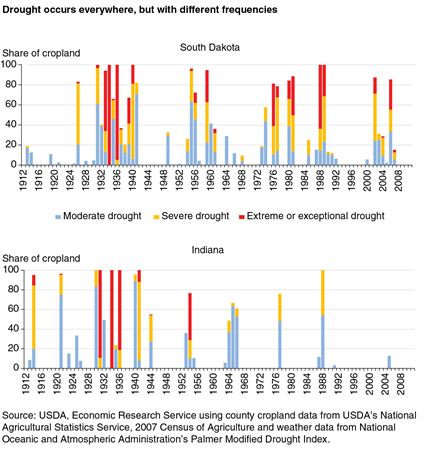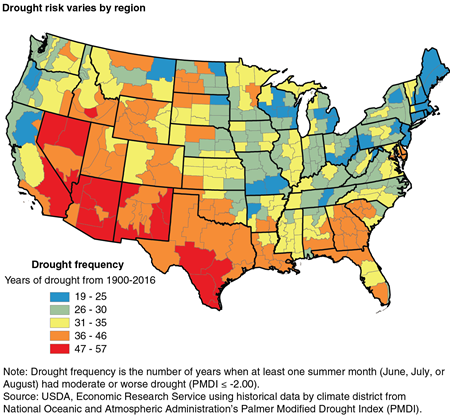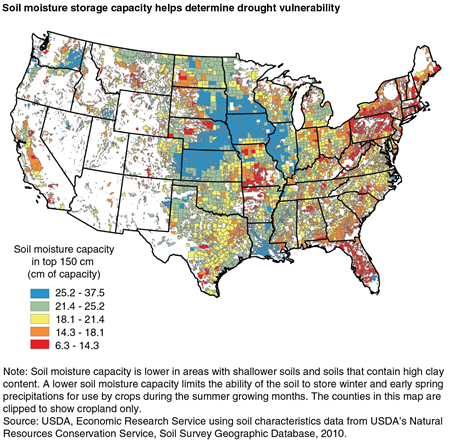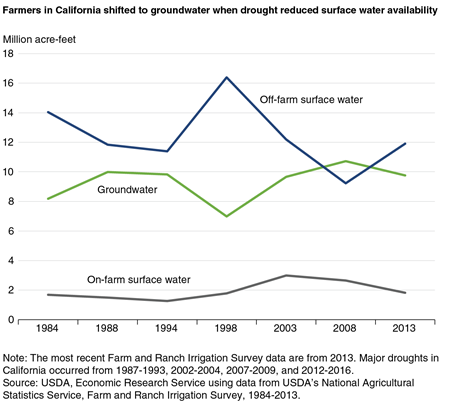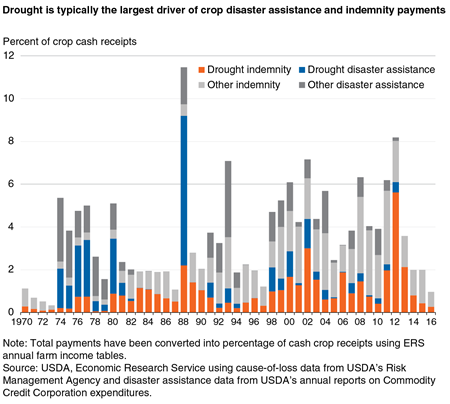Farmers Employ Strategies To Reduce Risk of Drought Damages
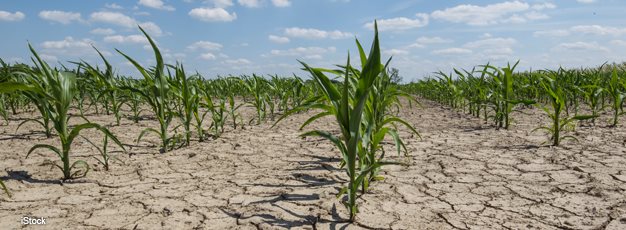
Highlights:
-
In regions with high drought risk, farms may experience a severe, extreme, or exceptional drought about once every 2 or 3 years; where the drought risk is lower, farms may encounter such a drought only once every 5 or 6 years.
-
Farmers can improve their drought resilience by making different crop choices, enrolling in crop insurance and other farm risk management programs, and investing in soil health.
-
USDA conservation programs—intended primarily to improve onsite and offsite environmental quality—may also help producers adapt to drought risk.
Drought is the leading driver of production risk in U.S. agriculture. Although flooding, early frosts, pests, and other risk factors pose major challenges to farmers, no other source of production risk is as nationally significant as drought in terms of lost agricultural production and income. A major drought can reduce crop yields, lead farmers to cut back planted or harvested acreage, reduce livestock productivity, and increase costs of production inputs such as animal feed or irrigation water.
In 2012, the U.S. Department of Agriculture (USDA) declared more than two-thirds of counties in the United States drought disaster areas. This was the most severe and extensive U.S. drought in over 50 years, and it underscored the far-reaching role that drought can play in agricultural production and policy.
At any given time, some portion of the country faces drought conditions. In recent years, large areas of the United States have experienced prolonged drought, with significant impacts across regional agricultural sectors. For example, the 2012 drought affected livestock, corn, and soybean producers of the High Plains and Midwest regions. From 2013 to 2016, all of California and parts of the Pacific Northwest faced serious drought conditions that depleted reservoir water supplies for irrigation. And, as of late 2016 and early 2017, moderate to severe drought conditions had extended across much of the U.S. Southeast.
Defining and Measuring Drought
Climatologists have developed various methods to measure the incidence and severity of different types of drought and regional drought risk. “Agricultural drought” generally results from a sustained period of below-average precipitation, often accompanied by above-average temperatures that exacerbate the dry conditions and lead to reductions in soil moisture reserves, groundwater or reservoir levels, and crop growth and production.
Precipitation and temperature vary widely by region, so climatologists measure droughts relative to local climate conditions. For example, the conditions associated with an extreme drought in central Ohio can look similar to average, nondrought conditions in semi-arid western Kansas. Farmers in different regions tailor their crop choices, production systems, and decisions on inputs (like how much fertilizer to apply) largely based on average weather conditions in their area—which makes them vulnerable when those conditions change.
Farmers can directly measure the intensity of a drought by checking their soils, plants, and rain gauges. In contrast, meteorologists, economists, and policymakers generally use a drought index to assess drought over a wider area. The most commonly used index is the Palmer Modified Drought Index (PMDI), for which large negative values indicate severe or extreme shortfalls in average soil moisture. Tools like the Drought Monitor—which is released weekly through a collaboration between USDA, the National Oceanic and Atmospheric Administration (NOAA), and the National Drought Mitigation Center—rely on the PMDI and several other indices to track location and duration of drought in the United States.
Since drought is measured relative to average conditions, a region cannot be in perpetual drought. An average year in an arid region by definition does not count as a drought. However, some regions are more likely to experience abnormally dry years, measured as a deviation from average precipitation and temperature. These regions face higher drought risk.
Drought Risk Varies With Regional Differences in Climate
Every region of the country has experienced serious drought at some point over the past few decades. But the frequency of drought varies greatly by region. Examining the PMDI over time reveals these differences in regional drought risk.
For example, between 1911 and 2011, South Dakota had about 15 years when more than half of the cropland experienced “severe or worse” drought, as measured by the PMDI. In contrast, Indiana had about 6 such years over the same period. Since “severe or worse” drought occurs more frequently in South Dakota, this State faces higher levels of drought risk than Indiana.
Drought risk, as measured by the PMDI, is closely linked to regional variability in rainfall. Many western and southeastern counties in the United States, where there is greater fluctuation in rainfall, face higher drought risk than central and northeastern counties, where it is more humid. Drought risk ranges from as low as 19 “severe or worse” drought-years per century for the lowest risk counties to as high as 57 “severe or worse” drought-years per century for the highest risk counties.
Drought Vulnerability Varies With a Variety of Factors
Drought risk measures how frequently a given area experiences a severe or extreme drought. However, droughts do not affect all farms equally. Drought vulnerability measures how sensitive a farm is to the occurrence of drought. For some farms, such as dryland farms with shallow soils, a relatively moderate drought can have a significant impact on production and income. For other farms, such as irrigators with plentiful groundwater supplies, only an extreme drought may have a comparable impact.
Some vulnerability factors are largely out of the control of farmers. For example, soils have large differences in water-holding capacity, which creates large regional differences in drought vulnerability across the United States. The ability of a soil to capture and retain moisture over a growing season can function like a bank account against which crops or forage can draw when a drought occurs. While soil characteristics are generally fixed for a given field, a soil’s water-holding capacity can be enhanced through good soil stewardship.
Farmers also have limited control over the availability of groundwater or surface water reserves for irrigation. And investment in irrigation infrastructure is often expensive. But irrigation reduces drought vulnerability in many areas by allowing farmers to apply water to the crops, augmenting precipitation. Some irrigators rely almost exclusively on large aquifers as a source of irrigation water, such as the Ogallala Aquifer in the High Plains and the Mississippi Embayment in the Southern Mississippi River region. In the intermountain West, many irrigators draw on both groundwater and surface water supplies.
In California and other Western States, surface water supplies may be highly vulnerable to drought. Reservoir storage systems in the Western United States help smooth out irrigation supplies during periods of reduced stream flows, providing a buffer against short-term drought. However, reliance on surface water for irrigation creates its own form of drought vulnerability. Prolonged drought generally results in large reductions in the quantity of surface water delivered, affecting farm production systems that depend heavily on surface water for irrigation.
Furthermore, most aspects of water allocation are under the purview of State laws. Several States have established institutions for allocating water rights among competing uses and users based on seniority. In periods of reduced water availability, senior water rights holders in those States are first in line for water allocation. Water is delivered fully in order of seniority until allocation limits are reached, and then remaining rights holders receive no deliveries. This may make irrigators with less senior water rights particularly vulnerable during periods of drought. In some areas, States and local water districts have established markets to allow for trading of water rights, which can provide a mechanism to reduce the vulnerability of less senior rights holders.
Groundwater may substitute as a source for irrigation water when the availability of surface water declines. For example, although most farmers in California’s main agricultural areas rely on surface water for their irrigation needs, many parts of the State have sufficient groundwater reserves to provide a partial buffer against the impacts of drought. Data from the Farm and Ranch Irrigation Survey conducted by USDA’s National Agricultural Statistics Service (NASS) illustrate the increase in groundwater use in California in response to surface water reductions during multi-year droughts in 1987-93, 2002-04, 2007-09, and 2012-16.
However, recurring drought and groundwater “overdraft”—when the amount of water extracted is greater than the amount of water entering the aquifer—have resulted in large declines in aquifer levels in some areas. In response, the California State Legislature passed and the Governor signed the Sustainable Groundwater Management Act in 2014, which will impact groundwater planning and withdrawals over the coming decades. Under this law, groundwater management districts must develop plans for achieving sustainable groundwater use within 10 to 20 years.
The reaction of commodity markets to droughts can also help mitigate the drought vulnerability of some farmers. When severe droughts occur in major production regions, reductions in yield often lead to increases in crop prices. Increased prices can offset a portion of the revenue loss for farms that lose some but not all of their yields. This offsetting effect varies by region, and more significantly reduces vulnerability when a drought-impacted region has a large market share for a given crop. However, the market response can also work against livestock producers by increasing feed costs during a drought and reducing the quality and availability of forage on pasture and rangeland.
Farmers’ Adaptation to Local Climate Includes Drought Risk-Reduction Strategies
Farmers can take factors like drought risk into account when deciding what to produce and how to produce it. For example, California farmers tend to grow almonds in areas that have access to both surface water and a highly reliable groundwater supply. This allows farmers to substitute groundwater for surface water—one reason that during the recent drought in California, farmers were able to continue producing almonds despite large cutbacks in surface water deliveries. Almond orchards require large capital investments, so locating them in areas with reliable water supplies limits investment risk. In areas of California without reliable groundwater, farmers are more likely to grow annual crops, such as cotton or corn silage, which do not require as large a capital investment and which may be planted on fewer acres or shifted to other crops during a major drought.
Any action that reduces drought vulnerability increases resilience. Farmers can make small but meaningful improvements in their drought resilience through investments and actions that enhance soil moisture-holding capacity. A variety of management practices that increase soil organic matter while reducing soil-moisture loss—such as no-till or reduced tillage, use of cover crops, and conservation crop rotations—may help farms adapt to drought risk. Evidence suggests, for example, that farmers in semi-arid areas like Kansas use no-till, fallow rotations, and cover crops explicitly for such purposes.
Investment in irrigation efficiency may also improve drought resilience. High-efficiency irrigation technologies—such as drip irrigation systems and Low Energy Precision Application (LEPA) sprinklers, whose nozzles drop low to the ground—generally reduce water lost to evaporation or run-off. Such systems make a greater proportion of water withdrawals available for crop use and help stretch limited water supplies. When increased water efficiency at the field level comes from a reduction in run-off or groundwater infiltration, this can reduce availability of water downstream for environmental purposes or for other surface water uses. Due to this potential unintended consequence of investments in irrigation efficiency, some local water management institutions may impose rules to ensure public funding of irrigation efficiency preserves or improves environmental flows.
Government Programs Play a Role in Drought Response and Preparedness
Since the Dust Bowl in the 1930s, drought has been an important focus of U.S. farm policy. Early Federal policy mitigated farmers’ drought-induced hardships primarily by providing ad hoc disaster assistance in response to a drought. With changes to the Federal crop insurance program in the 1990s, the emphasis of farm programs shifted from ad hoc disaster assistance to risk management, with a greater reliance on crop insurance to compensate farmers for drought losses. In fact, drought has been the largest individual driver of Federal indemnity payments and disaster assistance for decades.
Increased investment in drought resilience in advance of drought conditions—by both farmers and Federal programs—can reduce the need for and the cost of drought response. Such investments can take a number of forms (see table). Crop insurance enrollment acts as a form of farmer investment in drought resilience, as only enrolled farmers who have paid insurance premiums are eligible to receive indemnity payments during a major drought. By paying a portion of the crop insurance premiums, the Federal Government incentivizes greater enrollment in the insurance program and greater reliance on crop insurance for drought resilience.
| Plan | Short-term drought response | Farmer adaptation needed | Supporting Government action |
|---|---|---|---|
| Replace lost revenue | Collect indemnity and other farm risk management payments | Enroll in crop insurance and other farm risk management programs, as applicable | Establish viable farm risk management programs |
| Improve soil health | Increase soil moisture retention | Adopt conservation tillage, cover crops, etc. | Provide technical and financial assistance |
| Provide more usable water to irrigated crop | Reduce water losses in irrigation system | Invest in irrigation efficiency | Provide technical and financial assistance |
| Plant drought-tolerant crop varieties | [Action must be taken before drought] | Purchase drought-tolerant seeds | Engage in and support research and development |
| Expand access to grazing area | Exercise emergency haying and grazing provisions | Enroll in CRP | Establish emergency haying and grazing provisions |
Other Federal farm risk management programs enacted under the current farm legislation do not require premiums for producer enrollment. USDA’s Agriculture Risk Coverage (ARC) program provides partial compensation for revenue declines due to yield reductions under drought. The Livestock Forage Program (LFP) partially compensates livestock producers for grazing losses incurred under an officially declared drought, with payments indexed to severity categories under the Drought Monitor.
Farmers can also participate in a variety of other voluntary USDA conservation programs that allow them to build their drought resilience. Some of the conservation practices encouraged through USDA’s programs for working lands may have benefits for on-farm drought preparedness. For example, to provide an incentive for farmers to help improve water quality, the Environmental Quality Incentives Program (EQIP) provides financial and technical assistance for many of the soil conservation practices described above, which have the added benefit of improving soil moisture-holding capacity. ERS research shows that farmers in higher drought risk regions are more likely to enroll in EQIP contracts for conservation tillage, which minimizes soil disturbance and maximizes water retention. This suggests that farmers’ participation decisions in EQIP may be influenced by an interest in improving their drought resilience. Similarly, ERS research reveals that farmers using irrigation in higher drought risk regions are more likely to have EQIP contracts related to irrigation efficiency improvements.
The Conservation Reserve Program (CRP) is another USDA program that provides some measure of drought resilience. Under CRP, farmers can enroll environmentally sensitive, marginal cropland in long-term contracts that provide annual rental payments in exchange for establishing approved conservation cover crops. The stability of guaranteed rental payments over the term of the contracts, when compared to the prospect of farming the land or renting it out for crop production, can be valuable to landowners in regions facing higher drought risk. CRP also has emergency haying and grazing provisions that allow farmers to access forage on their CRP land during major droughts. Authorization of emergency provisions requires a USDA drought disaster determination, and in contrast to managed haying and grazing on CRP land, since 2014 emergency provisions do not require participating farmers to forego a portion of their CRP rental payments. Research at ERS has found that farmers are more likely to offer land for CRP enrollment in higher risk regions, even after controlling for other regional differences, suggesting that drought resilience may be an important driver of CRP program participation.
A variety of other USDA initiatives aim to improve drought preparedness and response, as well as long-run drought resilience. As noted earlier, USDA plays a role in determining drought disaster declarations and in maintaining the widely used Drought Monitor tool. Public investment in research and development in crop cultivars, irrigation technology, and production practices that enhance drought resilience helps reduce drought vulnerability. Examples of such research and development include projects by the USDA Agricultural Research Service (ARS) that explore drought-resistant varieties of crops and improved techniques for monitoring soil moisture.
In addition to Federal programs, various States have their own water conservation and drought-related programs. In some cases, State initiatives may leverage USDA programs; Colorado, for instance, has used USDA’s Conservation Reserve Enhancement Program (CREP) to compensate farmers who permanently retire irrigation water rights in the Republican River Water Conservation District. Permanent retirement of water rights acts as a long-term investment in drought resilience, helping to reduce surface water and groundwater demand conflicts during low-flow drought periods. A short-term version of this adjustment can occur through water trading and leasing, which require active local water markets or State water banks. Such water trading effectively transfers water to higher valued farm and non-farm uses, which can lessen regional economic damages from drought-induced water-supply shortfalls.
Conclusion
Several recent major droughts across the United States have prompted a shift in policy focus from short-run drought response towards building more long-run drought resilience. Farmers face differing levels of drought vulnerability, reflecting both variation in local drought risk and differences in farm operations and resource endowments. Consequently, they have employed a variety of strategies to enhance drought resilience. ERS research shows that USDA conservation policies may already function in a way that allows farmers to use USDA’s voluntary programs to partially mitigate drought impacts at the farm level.
The Role of Conservation Programs in Drought Risk Adaptation, by Steven Wallander, Marcel Aillery, Daniel Hellerstein, and Michael S. Hand, USDA, Economic Research Service, April 2013
Irrigated Agriculture in the United States, USDA, Economic Research Service, August 2019


